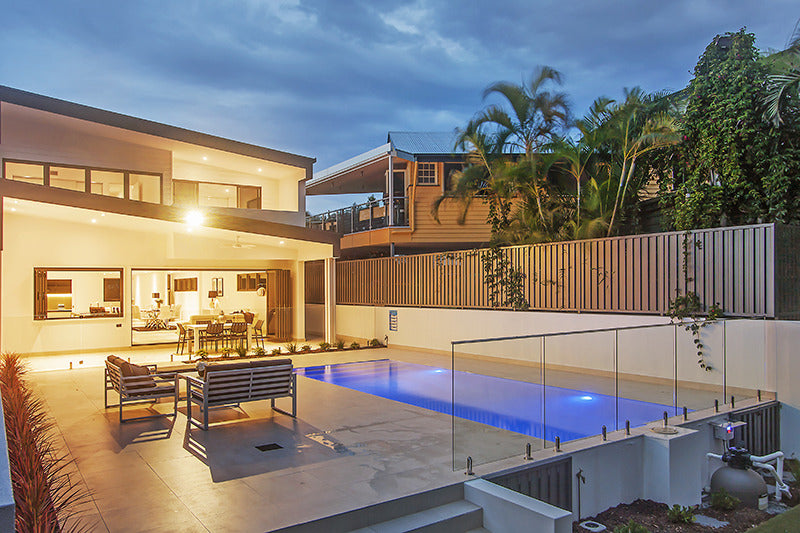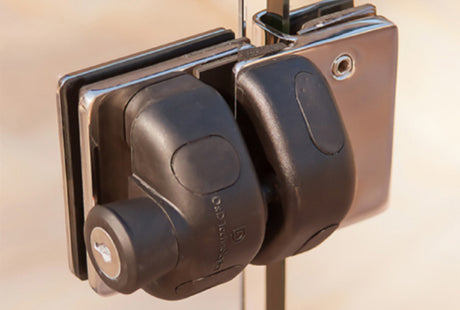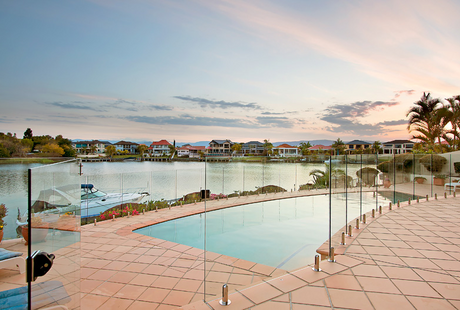Regulations & requirements for pool fences have changed dramatically in recent years. Statistical evidence has shown that the most drownings occur in backyard swimming pools, with the majority of these incidents occurring in children under 5. Inadequate pool fencing or failing to comply with Australian pool regulations can leave your family at risk. When you’re planning the placement of your pool you need to also plan where your pool fence will be to ensure that it’s safety compliant and allows for easy supervision of your children or pets.
Swimming pool fence placement
Where you place your pool fencing will depend on where your pool is positioned in the backyard. If you have a more confined space, you might be wondering how you’ll integrate a pool fence without making the backyard look closed-in. Swimming pools generally need to be at least 1000mm from the boundary. The boundary can be your backyard fence or a barrier that is suitable to be classified as a boundary fence. You should contact your local council to find out your location’s specific requirements. For many people with small backyards, the boundary or dividing fence is used as a pool fence to save space. This is an efficient way to save money on pool fencing as well as to create the illusion of a larger backyard. In most states, such as Queensland, using a boundary fence as a pool fence is compliant with pool safety regulations. You may also use the wall of a common boundary as long as it's compliant and as long as you gain permission from your neighbour.
Pool fence regulations
Pool fence regulations vary from state to state and are often updated to improve safety around water. Victoria, NSW, South Australia, Tasmania, Western Australia and the ACT are all the states that must adhere to the current Australian Standard AS1926-2012. In these states, the standard is called up by the Building Code of Australia (BCA). Queensland has its own standard in place, while Northern Territory operates under AS1926.1-1993.
Exemptions from the standard
There are two exemptions to the National Standard;
- Those states/territories that are affected through the BCA as a variation to the standard as it applies in a particular jurisdiction.
- Legislative exemptions to the application of the legislation.
For example, in NSW, spas are provided with an alternative to pool fencing and may have a lockable lid which must be locked when the spa is not in use. Also in NSW, an out-of-ground wall of a pool is not permitted to be used as a barrier.
The basic criteria for pool fencing regulations, regardless of state, include:
- Pool fencing must be a minimum height of 1200mm.
- The top of the fence must be a minimum of 900mm and away from climbable objects such as trees, BBQs, toys and furniture.
- Gaps between fencing must be less than 100mm.
- The pool fence must be constructed from durable materials. This includes steel, timber and glass.
- Gates must be self-closing and swing away from the pool.
- Gate latches must be mounted pool-side.
Doors in pool barriers
If you have a door that forms part of a pool barrier you must make sure that:
- It’s self-closing and self-latching
- The latching device is at least 150cm off the ground
- It has a non-climbable zone of 90cm that is at least 120cm above the floor
- It opens away from the pool
- It does not have any pet doors
Windows in pool barriers
If you have windows that form a part of your pool barrier, they must:
- Have a locking device or security screen fixed to the building that prevents them from opening more than 10cm
As drowning is the number one cause of preventable deaths in children under 5 in Australia, ensuring your pool and pool fencing is compliant with National Standard’s will keep your family and loved ones safe. Another important thing you should do and keep on top of is the regular maintenance of your pool fence or boundary to ensure there are no holes, gaps, falling palings or damage. Any damage to your pool fence/boundary renders your fencing unsafe and should be rectified immediately.
State regulation resources
For more specific information on pool fencing regulations in your state, click the relevant link below:
Install compliant glass pool fencing
Thinking of getting glass fencing for your pool? We’d love to chat to see how we can help bring your pool to life, get in touch with us here.


